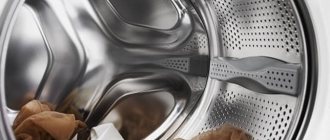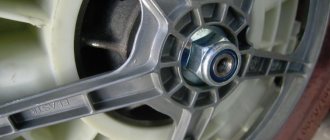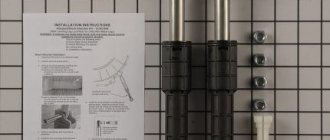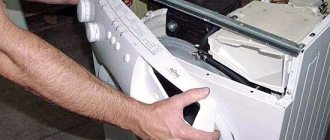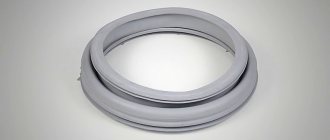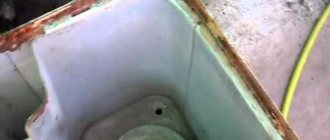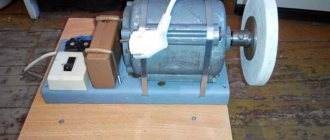Very often, noise during spinning and washing is caused not by major breakdowns, but by simple wear of the lubricant. To update the layer on the bearing, shock absorbers, drum and pump, you will have to completely disassemble the washing machine. This is the main difficulty, the rest of the operations are simple.
Bearings in a washing machine
This part is the most important element, the performance of which is required for the proper functioning of the equipment. Let's look at the main aspects of the product:
Description
A bearing assembly is a link connecting the pulley and drum of the equipment. It is most often installed in a cross located in the tank. The assembly includes two types of bearings, which differ significantly in size, distributed as an internal part and an external one.
Manufacturers present two types of parts - metal and plastic. The first type is considered more resistant to wear.
Purpose
The part is installed on the drum shaft; when the equipment is operating, the bearings control the correct operation of the device. The rotation is smooth and without any beats or vibrations.
We purchase a lubricant composition
On sale you can see several special lubricants for washing machine parts. Each product has different properties. The composition used for processing bearings and oil seals should be:
- moisture resistant. The purpose of the seal is to protect the bearing from water. That is why the lubricant for the rubber seal must be resistant to water and not be washed out by it over time;
- resistant to temperature changes. During operation of the machine, the water is heated up to 95 degrees in certain programs. Also, the shaft, when rotating, becomes very hot. Only a heat-resistant composition will not lose its properties and will provide protection against water entering the unit;
- suitable for rubber parts. Oil seals lubricated with a low-quality substance can become very hard, or, on the contrary, soften. This will lead to the seal being broken;
- thick. Then the composition will not leak out when using the washing machine.
Automotive lubricants are completely ineffective for lubricating washing machine bearings; it is better not to use them during repairs.
Typically, service center technicians use the following lubricants:
- AMPLIFON - waterproof composition from an Italian manufacturer;
- Anderol is a product recommended specifically for Indesit machines. It has two forms of release - in a jar weighing 100 g, or in syringes;
- STABURAGS NBU 12 is a waterproof and temperature-resistant composition that has proven itself on the market;
- LIQUI MOLY “Silicon-Fett” is an expensive German lubricant. A very high quality product that meets all requirements. Available in fifty gram tubes.
When choosing a composition for processing bearings and seals, carefully read its characteristics and parameters. Study reviews from users and experts.
How to lubricate the bearing in a washing machine?
Timely care of the part will significantly extend the service life of the equipment. But the lubricant, in turn, must be selected carefully and in accordance with the requirements of household equipment.
There are a sufficient number of varieties of this composition on the modern market. The right choice will provide reliable protection of the part from wear, the main thing is to select the lubricant characteristics according to the requirements of the washing machine.
It must meet the following parameters:
- Availability of moisture resistance.
The oil seal is a sealing ring that is attached to the bearing itself, which rotates on the shaft. Thanks to this, water does not penetrate into the part. Therefore, the lubricant should not be washed away during operation of the mechanism.
- Heat resistance.
The water in the drum sometimes heats up to 90 degrees, which should be taken into account when purchasing a lubricant; it should not lose its characteristics when heated.
- Suitable.
An important aspect is compatibility with rubber; a poor-quality composition can ruin it - greatly soften it or, on the contrary, make it hard and unsuitable for use.
- Density.
The grease must remain on the bearing even when the drum is heavily loaded.
Important to remember! You cannot use the automotive version of the lubricant, as they are not intended for washing machines. Bearings quickly fail after using such a lubricant.
What and where to lubricate
Not many people know that bearings require maintenance, but oil seals are also required to be lubricated. Usually the bearings already have grease in them.
If this part is original, made at the manufacturer and bought in a specialized store, then you can put it in the car without additional processing.
Otherwise, questionable quality necessarily requires preliminary care, because cheap materials and lubricants are usually used, among other things. It's better to update it yourself.
Everything needs to be lubricated! Bearings, seals and bushing. But! There should be one lubricant for them. You cannot mix different products.
Disassembling the washing machine
Lubricating the bearing of a washing machine without disassembling is not possible, so the process of lubricating the internal parts is labor-intensive.
This is necessary in order to get the tank with the drum in which the part we need is located. Before work, the equipment is de-energized and disconnected from the water supply. The machine is placed in a place with free access to it. You will need pliers and screwdrivers.
The top cover of the machine, which is held on by two bolts at the back, is removed.- The compartment for detergents is pulled out.
- The wires from the board are disconnected and the control panel is disconnected.
- Using a slotted screwdriver, the clamp is removed, which is removed by pressing the spring. Then the edges
the elastic bands are tucked into the drum and the cuff is removed. - The bottom panel must be removed. It is secured with latches.
- Next, the front panel is removed. To do this, the bolts are unscrewed behind the powder receiver.
All wires and pipes that go to the tank must be unhooked.- The pressure switch with wires is removed and the front panel is pulled out.
- Both counterweights are removed to make the tank lighter.
- The tank is removed from the springs, having first unscrewed the shock absorbers. The tank is placed on the floor with the pulley facing up.
- The belt is removed from the engine, and then the engine itself.
If something cannot be disconnected or removed during operation, do not use force. You can fill soured screws with WD-40 and drill out broken ones.
Often, in order to be able to reassemble the machine in reverse order, users take photographs of each stage of work and the correct connection of the wires with the pipes.
You need to pay attention to the tank. There are two types: collapsible and solid. If you have a Hotpoint-Ariston washing machine, for example, then most likely the tank is non-separable. In this case, it will have to be cut to get to the bearings. It is sawed with a hacksaw along the joint seam. The halves are connected back together using bolts and sealant.
If the tank is collapsible, then it needs to be opened by unscrewing the bolts.
How to remove bearings
So, the tank is disassembled.
Now you need to release the drum pulley , which is held in place by a nut. If the bolt does not want to come out, use WD-40. Next, the drum itself is removed by rocking the pulley housing.
To separate the drum from the tank, the shaft is carefully knocked out. There are bearings in the seat on both sides that need to be knocked out.
After this, an inspection is carried out: which bearing is worn out or broken?
If damaged, you will have to buy a new bearing and seal.
How to lubricate bearings in a washing machine? If there is no damage, then they are cleaned of dirt using WD-40, wiped with a cloth and then filled with lubricant. Such maintenance of this part should be carried out once every five years . If the bearing is dismountable, then the protective cover is removed from it (it is convenient to do this with a scalpel) and treated with lubricant inside the part.
If the bearing is new, it does not need to be lubricated, unlike the oil seal. This is done simply, the product is applied in an even layer to the side that comes into contact with the bushing. First the installation is done, and then the seals.
The bearing lubrication process itself is not complicated. It is difficult to get to it, which is why the services of a specialist are much more expensive than the cost of a new part.
Without knowledge and experience in such a matter, there is always a risk of damaging the drum, which will lead to a complete replacement of the washing machine. But, despite this, it is quite possible to cope on its own.
What happens if you don't lubricate bearings in washing machines?
Some people wonder whether it is necessary to lubricate this element? Preferably, experts say so. Bearings are responsible for the performance of the equipment; if noise and grinding noises appear in the product, it means that the drum is not working properly.
The bearings are responsible for the serviceability of this part; they ensure smooth rotation of the drum.
If a grinding noise appears, it means that it is not spinning smoothly, and therefore may soon become unusable. In addition, this may cause the operation of other parts that are part of the washing machine to malfunction. The result of this problem may be the final breakdown of the equipment, which will no longer be subject to restoration.
Alternative options
Manufacturers recommend choosing original compounds designed for specific models for bearings and seals of washing machines to ensure maximum protection of the parts. In reality, they are no different from the universal options, but their cost is several times higher.
Since every person tries to save money, but at the same time get a high-quality composition, you can pay attention to the lubricants used in the process of maintaining various devices, which are also suitable for the oil seal of a washing machine:
- "Litol-24".
- "Ciatim-221".
- Ambligon.
How to find a bearing in a washing machine?
To find this part you need to complete several steps:
- Disassembling the washing machine;
To do this, you need to remove the cover by unscrewing two bolts located on the rear panel. Then the tray for the washing powder is removed, then the upper instrument part is removed by unscrewing all the bolts on it. Next, the wires are disconnected.
Important! The process of disassembling the product must be photographed in detail so as not to confuse the assembly sequence later.
Removing the bottom strip is simple and quick using a flat-head screwdriver.
- Removing the hatch cuff;
This is the name of the rubber gasket, which is the connecting element between the drum and the hatch opening.
- Removing the front panel;
You can’t pull it too hard, as you can damage the integrity of the part.
- Removing and disassembling the tank.
This stage requires care and the right approach. It is imperative to photograph the process in great detail, since disassembling the tank is difficult.
Stages of work
You need to start by disassembling the washing machine and removing the bearings. For any brand and model, the disassembly principle is almost the same.
Start by removing the panels
Remove the top cover by removing the screws from the back that hold it in place. Then push it forward and out of the way.
Remove all the screws around the perimeter of the back panel that hold it in place. Now move to the front of the case.
- Pull out the detergent tray by pressing the lock in the center.
- Unscrew the bolts that are located behind the tray, as well as on the opposite side of the control panel.
- Release the plastic latches and remove the control panel. If you decide to unfasten all connections, take photographs of their locations in advance.
- Open the hatch door. Bend the cuff and remove the clamp. Place the sealing rubber inside the tank.
- Remove the two screws holding the hatch lock. Unfasten the wiring from the lock.
- Unscrew all screws holding the front panel.
Remove parts from top of tank
Remove the upper counterweight by unscrewing the mounting bolts.
Now you need to get the powder receptacle. Using pliers, loosen the clamp that secures the pipe to the cuvette. Disconnect the pipe. The filler valve hoses are also attached to the powder receiver. You can disconnect them, but it is easier to remove them together with the valve. For this:
- Unscrew the bolt on the back wall that holds the valve.
- Disconnect the wiring from the valve and remove it from the housing along with the cuvette.
Also unfasten the pressure switch hose that is attached to the tank.
Move to the front of the body
Remove the front tank counterweights by unscrewing the bolts.
If the heating element of your washing machine is located in front under the tank, disconnect its connectors. Then, using wire cutters, remove the wiring clamps and remove it from the tank. Unscrew the screw of the drain pipe clamp. Remove it from the tank.
Be careful, water may spill out of the spigot.
Disassemble from behind
Remove the drive belt by pulling it to the side and turning the pulley.
If the heating element of the car is located at the rear, unfasten its wiring, as well as the engine connectors. Now unscrew the motor bolts and pull it out of the housing.
Unclench the plastic clip and unfasten the pressure chamber that is attached to the tank. Unscrew the shock absorber bolts. Lift the tank and remove it from the hooks, pulling it out of the housing.
Place the tank on a flat surface. Remove the sealing rubber of the hatch by removing the inner clamp. Turn the tank over and remove the pulley by unscrewing the central bolt. Pre-secure it with a wooden plank.
Separate the two parts of the tank by unscrewing the screws around the perimeter. Take out the drum. Now you get to the bearings. Now you will learn how to properly lubricate a bearing in a washing machine.
Finish work
Remove the bearings from the tank. To do this, pry the oil seal with a screwdriver and pull it out. Place a chisel on the outer race of the bearing and, tapping with a hammer, knock it out of the tank. Do the same with the second element.
If you have decided which bearing lubricant is best to choose, then after cleaning you need to remove the protective cover of the part. The product is placed inside.
But how is a non-separable, sealed bearing lubricated?
- Take WD-40, spray the parts with it and wipe well with a rag.
- After cleaning, you need to open the lid, but it does not work.
- Fill the inner ring of the part with a plastic bag.
- Take a tube of lubricant and cut the neck so that it is equal to the diameter of the inner ring of the bearing.
- Place the tube on the inner race and squeeze out the lubricant until it starts to come out from the opposite side.
- Then start rolling the bag around inside to distribute the lubricant. If you were wondering whether sealed bearings need to be lubricated, now you know what is necessary and possible.
- Remove any excess. Reinstall the part.
Tips for using your washing machine
Proper use of household appliances is an important aspect in operation. To avoid sudden breakdowns, it is advisable to follow some recommendations:
- Do not load the body of the washing machine;
- There is no pressure on the loading hatch;
- It is not advisable to allow small children who actively use the software buttons unnecessarily to access the device;
- Pets must be kept in close proximity to the device;
- Avoid transfusion;
- Use the device strictly according to the instructions;
- It is not advisable to change the program mode when water has already been collected in the machine;
- Do not rinse the drum with a stream of running water;
- To care for the product, use mild cleaning agents that do not scratch the surface.
Description of the procedure
New branded bearings and oil seal, manufactured specifically under the Samsung brand, are prepared for installation in the machine and do not require additional lubrication. If you purchase questionable components from an unknown manufacturer, it is recommended to update the lubricant. Old bearings in the machine must be inspected for damage, and if there are no defects, it is permissible not to replace them, but simply lubricate them generously with a special compound.
Before processing, the parts are cleaned of dirt using a WD-40 aerosol, and only then lubricated.
If the bearing is dismountable, then first, using a tool, remove its protective cover, then add lubricant. The substance is applied evenly along the inner ring in contact with the bushing. After processing, the bearing is lubricated and an oil seal is installed.
How to properly lubricate a non-separable bearing? The part is also pre-treated with WD-40 aerosol and wiped with a dry cloth. The protective cover in sealed bearings simply does not give way. The algorithm for further actions will be as follows:
- Fill the inner ring of the element with polyethylene (a regular bag);
- cut the neck of the tube with lubricant so that its diameter matches the size of the ring;
- place the tube with the substance on the inner ring, start squeezing out the lubricant until it appears on the other side;
- scroll the bag to distribute the lubricant inside;
- wipe off the excess with a rag, install the part in its original place.
Thus, both collapsible and sealed bearings are subject to mandatory processing. There are no problems with lubrication in both the first and second cases.
It is important not to forget about applying the composition to the rubber seal. Be sure to lubricate not only the bearing, but also the oil seal of the Samsung washing machine. The gum is processed using a regular syringe. The internal groove of the seal is filled with the substance, after which the oil seal is put back.
Removing parts that interfere with access to the tank
The next step is to remove the upper counterweight - a concrete block that gives the SMA stability. Next, the dispenser is taken out; to do this, the clamp securing the pipe to the tray is released. The filler solenoid valve tubes are also connected to the powder receiver. You can unhook them from the cuvette or remove the container along with the valve. Removing the filler valve is simple: unscrew the bolt that secures it, disconnect the power supply. Pull out the element along with the dispenser. Further:
- disconnect the water level sensor pipe from the tank;
- remove the front counterweights of the machine;
- unfasten the connectors of the heating element, remove the heater;
- loosen the drain pipe clamp, disconnect it from the tank;
- tighten the drive belt;
- Unscrew the bolts holding the engine, pull out the engine;
- loosen the clamp and unfasten the pressure chamber attached to the tank;
- unscrew the screws of the shock-absorbing springs;
- lift the tank to remove it from the special hooks and remove the element from the housing.
Next, you should place the tank on a flat surface, remove the hatch cuff, releasing the inner clamp. Afterwards the pulley is removed; to do this you need to unscrew the central screw. After unscrewing the bolts around the perimeter of the connecting seam of the tank, divide it into halves. Remove the drum so that the bearings and seal are in front of you.
Interesting:
- How and with what to lubricate a bearing in a washing machine
- How to change a bearing on a Samsung washing machine
- How to lubricate the bearing of an LG washing machine?
- How to change the seal on a washing machine?
- How to change the bearing in a Daewoo washing machine?
- DIY podium for a washing machine
Reader comments
- Share your opinion - leave a comment
We use Anderol waterproof lubricant
As a rule, Anderol waterproof lubricants are sold at retail outlets where washing machines and spare parts for units are offered. But the price characteristics of this product will be unpleasant for you: after all, these are highly specialized lubricants that are not sold in ordinary stores.
Some washing machine suppliers produce oil seal lubricants designed for each specific unit. But in some cases, such products can be used for any other device, because lubricants are interchangeable. When purchasing this composition, look at what components are included in the lubricant. Products based on silicone and titanium, which perfectly repel liquids and are not afraid of high temperatures, sell well. These products are applied using a syringe.

